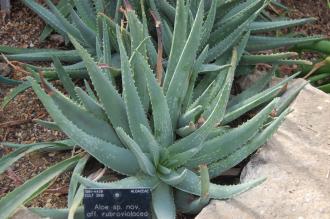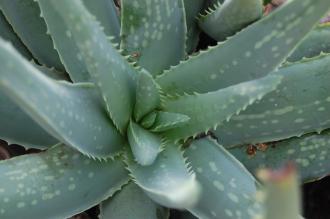
Aloe rubroviolacea (28/02/2016, Kew Gardens, London)
Position: Full sun
Flowering period: Autumn
Soil: Moist, well drained
Eventual Height: 60cm
Eventual Spread: 60cm
Hardiness: 9a, 9b, 10a, 10b, 11
Family: Xanthorrhoeaceae
Sub Family: Asphodeloideae
Aloe rubroviolacea is an evergreen succulent perennial with a rosette forming habit. Its blue/ green fleshy leaves are triangular with toothed margins, up to 30cm long, 4cm across at their base and arranged spirally. This plant produces a stem which allows the head of this plant to sprawl with new shoots emerging from its base. Its leaves become pink/ red during the winter months. Its red flowers appear on unbranched flower stalks which are up to 80cm tall.

Aloe rubroviolacea Crown (28/02/2016, Kew Gardens, London)
Aloe rubroviolacea, commonly known as Arabian Aloe, is native to the mountainous regions of Yemen and Saudi Arabia. In its native habitat it grows on rocky slopes in mountainous regions.
The etymological root of the binomial name Aloe is derived from the Semetic alloeh a name for this genus. Rubroviolacea is derived from the Latin rubra meaning ‘red’ and violacea meaning ‘violet coloured’, in reference to its winter leaves.
The landscape architect may find Aloe rubroviolacea useful as a suitable specimen plant in a rock or desert garden setting. Its is also suitable for growing as a houseplant, suitable for bright conditions. Once established this plant is very drought tollerant.
Ecologically, Aloe rubroviolacea flowers are attractive to pollinating insects.

Aloe rubroviolacea Leaf (28/02/2016, Kew Gardens, London)
Aloe rubroviolacea prefers moist, well-drained soils. It tolerates most pH of soil. It dislikes wet soils.
When maintaining Aloe rubroviolacea as a houseplant its soil should be watered regularly, but sparingly. Watering should be reduced during the winter months. Its preferred active growing temperature rages from between 18ºc to 28ºc, although it will tolerate a temperature below freezing. Feeding with weak fertiliser solution should be carried out once a month during the growing season. Cuttings may be taken from sprawling plants, placed in moist sand for a couple for weeks, during which period they will root.

Landscape Architecture

